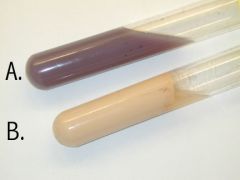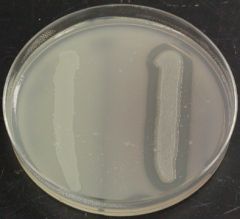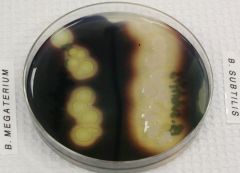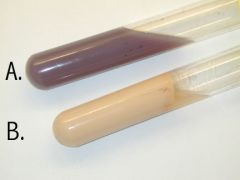![]()
![]()
![]()
Use LEFT and RIGHT arrow keys to navigate between flashcards;
Use UP and DOWN arrow keys to flip the card;
H to show hint;
A reads text to speech;
148 Cards in this Set
- Front
- Back
|
What is the term given to the group of mesophiles that can survive short of periods of high temperature?
|
Thurmoduric bacteria
|
|
|
What is the term for mesophiles that show growth below 20˚C?
|
Psychrotrophs
|
|
|
Which microbes are responsible for food spoilage in the refrigerator?
|
Psychrotrophs
|
|
|
Any undesirable change in smell, taste or texture of food is called ______.
|
spoilage
|
|
|
If there are not enough colonies in a culture worth taking notice of it is said that are ______ (acronym).
|
TFTC-to few to count
|
|
|
If a culture is overrun with colonies and it would take all day to count them or it is not possible to distinguish between colonies we say they are _______ (acronym).
|
TNTC-to numerous to count
|
|
|
the process of producing cultures from dilutions of an original sample for the purpose of finding the number of bacteria in the original culture is called _______.
|
Plate count technique
|
|
|
What are three factors that affect the number of bacteria present in a food?
|
1)type of food, 2)method of processsing, 3)method of storage
|
|
|
What is a dilution?
|
A fixed volume is removed from a culture or sample and added to a tube containing a specific volume of dilution fluid.
|
|
|
What is serial dilution?
|
Making a dilution from a dilution from a dilution until the desired dilution is obtained.
|
|
|
What are the three main types of pipets used in Biology labs?
|
1)Pasteur pipets, 2)volumetric pipets, 3)graduated pipets
|
|
|
Which kind of pipet is capable of transfering exact volumes with a fixed range?
|
Graduated pipets
|
|
|
Which pipet is used for transfering an exact given volume accurately but only that volume.
|
Volumatric pipet
|
|
|
If I am transfering fluid in a 1.0 ml graduated pipet and the fluid is drawn up to the 0.9 ml mark how much liquid am I transfering?
|
0.1 ml of liquid
|
|
|
If I want to transfer 0.3 ml of liquid what mark should I draw the liquid up to.
|
0.7 ml mark
|
|
|
How does using a drain-out pipet differ from using a blow-out pipet?
|
The volume at the tip of a blow-out pipet is transfered but it is discarded when a drain-out pipet is used.
|
|
|
What is the purpose of handling only the upper portion of a pipet and never allowing the lower portion to touch a nonsterile surface?
|
To prevent contamination of sterile pipets.
|
|
|
What dilution is produced when 100 grams of food are added to 900 mls of saline?
|
1 to 10 or 10ˉ¹
|
|
|
What dilution is produced when 9.0 mls of a dilution fluid is mixed with 1.0 mls of a sample?
|
1 to 10 or 10ˉ¹
|
|
|
What is the purpose of the serial dilution procedure?
|
To reduce the number of in a sample so each will form an isolated colony on a culture plate.
|
|
|
What effect does adding 0.1 ml instead of 1.0 ml of a dilution to an agar plate have on the dilution factor?
|
In increases the dilution facto by 1/10 (one tenth)or 10ˉ¹
|
|
|
What group ot bacteria present in food is responsible for botulism?
|
Clostridium
|
|
|
What group of bacteria present in food are responsible for causing deseases.
|
clostridium, Staphylococcus, Escherichia and Salmonella
|
|
|
How is processing methods related to the number of bacteria present in a food?
|
Cutting, shredding, and exposure to air and nonsterile surfaces increase the number of bacteria present.
|
|
|
Why doesn't the large number of bacteria in bacteria in milk pose a threat to our health?
|
the method used to process milk kill any pathogen bacteria in milk.
|
|
|
What is the method used to process milk?
|
Pasteurization
|
|
|
Why don't we worry about the pathogens in hamburger?
|
Cooking (applying high temperatures)kills any pathogens present.
|
|
|
What potential pathogen can be isolated using EMB agar?
|
Gram-negative, lactos fermenting, coliform bacteria: Escherichia coliform
|
|
|
How can spoilage of food be prevented or delayed?
|
Proper processing to destroy microbes or storing at temperatures to low to allow microbial growth.
|
|
|
What types of bacteria can be isolated from canned foods?
|
Thermophiles and thermoduric bacteria
|
|
|
What types of bacteria are found in pasteurized milk?
|
nonpathogenic psychrophiles and psychrotrophic basteria
|
|
|
Why would say that freezing foods is microbistatic?
|
because it only haults the growth of the microbes present but doesn't kill them.
|
|
|
Why would we not worry about a frozen food containing Clostridium botulinum.
|
Because the cold temps wouldn't allow the bacteria to grow so they couldn't produce the toxin and when we do thaw the food we cook it soon after which then kills the vegetative cells.
|
|
|
What is the basic assumption that allows us to relate the number of colonies to the number of bacteria in a diluted sample?
|
Each isolated colony grew from one bacteria present.
|
|
|
What is the ideal colony counting range?
|
30-300 colonies
|
|
|
How many colonies present would be considered TFTC?
|
less than 30 colonies.
|
|
|
Why do we designate these plates TFTC?
|
because they most likely resulted from contamination or sampling errors and can have a significant effect on our number of bacteria per gram calculated from the count.
|
|
|
0.1 ml from a 10^-3 dilution added to agar plate what is the total dilution factor?
|
10^-4
|
|
|
It was that a sample contained 8.0 X 10^5 and 80 colonies were counted on the agar plate what was the total dilution factor?
|
10^-4
|
|
|
If the total dilution factor is 10^-4 what would the dilution of the sample taken be?
|
10^-3
|
|
|
What is an enzyme?
|
a molecule that acts as a biological catalyst accelerating chemical reactions in living cells but remaining unchanged themselves.
|
|
|
What is an exoenzyme?
|
an enzyme released by microbes that can break down large molecules, often nutrient sources, in the environment.
|
|
|
What is an endoenzyme?
|
enzymes produced by microbes that function inside the microbe itself.
|
|
|
The term given to the substance acted upon by and combines with the enzyme at a specific site on its surface is _____.
|
substrate
|
|
|
The splitting of molecules by adding H2O to them is called ______.
|
hydrolysis
|
|
|
What type of enzyme is amylase and what is it's substrate?
|
Amylase is an exoenzyme and it's substrate is starch.
|
|
|
What type of enzyme is catalase and what is it's substrate?
|
Catalase is an endoenzyme and it's substrate is H2O2.
|
|
|
What type of enzyme is gelatinase and what is it's substrate?
|
Amylase is an exoenzyme and it's substrate is protein.
|
|
|
What type of enzyme is lipase and what is it's substrate?
|
Amylase is an exoenzyme and it's substrates are lipids or fats.
|
|
|
What type of enzyme is oxidase and what is it's function?
|
Oxidase is an endoenzyme and it's function is to catalyzes the transfer of eֿ to the last cytochrome carrier in the ETS.
|
|
|
What type of organic molecule are starches?
|
polysaccharides
|
|
|
Tributyrin is what kind of organic molecule?
|
Lipid or fat
|
|
|
What chemical is added to an agar plate to detect for starches?
|
The indicator iodine.
|
|
|
How do we tell which microbes hydrolyse starch and which ones don't?
|
The microbes that hydrolyze starch will show no dark blue or black color in the surrounding agar because they have used up the starchs closed to them where as the others didn't and the agar turns color around them.
|
|
|
How do we tell if a colony hydrolyzes tributyrin(fat)?
|
there will a clear ring around eash colony that breaks down fat do to the dispersal of fat droplets in the agar.
|
|
|
Gelatin is what type of organic molecule?
|
Protein
|
|
|
Why did we put the tubes of gelatin in the refrigeratorprior to observing for hydrolysis?
|
At room temp all gelatin is a liquid so we cool it down to solidify it but the hydrolysed gelatin remains a liquid even at cool temperatures.
|
|
|
What are the end products of the hydrolysis of proteins?
|
amino acids
|
|
|
If your end products aor glycerol and fatty acids what have we hydrolysed?
|
lipids or fats
|
|
|
What molecule do we hydrolyze to get glucose?
|
Starch or polysaccharides
|
|
|
If we put H₂O₂ on a culture and it bubbles what can we assume is present and what is in the bubbles?
|
Catalase and O₂ is in the bubbles.
|
|
|
What do obligate aerobes and facultative anaerobes need catalase?
|
aerobic respiration produces some H₂O₂ which is toxic.
|
|
|
Why do obligate anaerobes die in the present of O₂?
|
they die from a build up of H₂O₂ because they don't produce their own catalase.
|
|
|
List genera that we know do not produce catalase.
|
Clostridium and Streptococcus
|
|
|
What si the reagent used to detect oxidase?
|
reduce tetramethyl-p-phenylenediamine dihydrochloride
|
|
|
After we apply the reagent what color do we look for on the oxidase positive colonies?
|
purple
|
|
|
Oxidase is most often found in aerobic bacteria. True or False?
|
True
|
|
|
List two pathogens that are oxidase-positive.
|
Pseudomonas aerupinosa adn Neisseria gonorrhoeae (N. meningitides)
|
|
|
What is a microaerophile?
|
a microbe requiring less than 21% free O₂ for optimal growth.
|
|
|
Define a facultative anaerobe.
|
a microbe that uses free O₂ when it's available but can also in it's absent.
|
|
|
What is a microbe that requires atmospheric levels of free O₂ for growth?
|
A strict aerobe.
|
|
|
What % O₂ is atmospheric level?
|
21%
|
|
|
In which type of microbe can the pasteur effect be observed?
|
Facultative anaerobes
|
|
|
What is a aerotolerant anaerobe?
|
a microbe the O₂ has absolutely no effect on it's growth.
|
|
|
What is the name of the reducing agent the removes O₂ in the thioglycollate medium?
|
thioglycollic acid.
|
|
|
Describe the pasteur effect as seen in the thioglycollate medium.
|
heavier growth near the top of the medium where there is mor free O₂ present and less in the bottom where there is no free O₂.
|
|
|
Which types of microbes will grow in both the anaerobic jar and the thioglycollate medium?
|
Facultative medium, obligate anaerobes, and aerotolerant anaerobes.
|
|
|
What is the name given to the enzyme that breaks down starches or carbohydrates?
|
Amylase
|
|
|
What is the term given to the reaction of breaking down larger molecules into smaller ones by adding water?
|
Hydrolysis
|
|
|
What is the enzyme that has tributyrin for it's substrate?
|
Lipase
|
|
|
What kind of organic molecule is tributyrin?
|
Lipid
|
|
|
What molecule is broken down to yeild fatty acids and glycerol?
|
Lipid
|
|
|
What is the term given to a chemical used to show the present of a certain substance usually added at the end of a reaction?
|
Reagent
|
|
|
Iodine is the reagent for type of molecule?
|
Starch
|
|
|
What color does the medium turn in the presence of a starch hydrolyzing microbe after adding iodine?
|
It doesn't change- the medium around microbes that don't hydrolyze starch will still contain starch and will turn dark blue to black.
|
|
|
If we do a test to see if a microbe hydrolyzes starch we are really testing to see if the microbe produces what enzyme?
|
Amylase
|
|
|
What color is tributryin agar?
|
milky white
|
|
|
What do we look for to see if tributyrin is being hydrolyzed?
|
A clearing in the medium around the colonies.
|
|
|
If a microbe can hydrolyze tributyrun what bilogical catalyst is present?
|
Lipase
|
|
|
What medium is used in the gelatin hydrolysis test?
|
nutrient gelatin
|
|
|
Is gelatin a solid or liquid at room temperature?
|
liquid
|
|
|
If the gelatin remains a liquid after being place in the refrigerator what does this indicate?
|
that the gelatin was hydrolyze.
|
|
|
When gelatin is hydrolyzed what are the products of the reaction?
|
amino acids
|
|
|
What are the only two tests we performed on TSA agar?
|
Catalase and oxidase production
|
|
|
What chemical acts as both the reagant for and the substrate for catalase?
|
Hydrogen peroxide
|
|
|
What is the identifying characteristic after adding H2O2 (hydrogen peroxide) to the culture if catalase is present?
|
Bubbles filled with oxygen
|
|
|
Reduced tetramethyl is the chemical that acts as both the reagent and substrate for what enzyme?
|
Cytochrome oxidase
|
|
|
What type of microbe would be expected not to have catlase or oxidase?
|
Obligate anaerobes
|
|
|
Why do aerobic microbes need catlase and oxidase?
|
catalase-to break down the toxic by product of aerobic respiration H2O2, oxidase to carry the electrons from the last step in the ETS so respiration doesn't stop.
|
|
|
What medium do we used to test for gulcose fermentation?
|
Phenol red glucose broth.
|
|
|
What is the difference in the medium in the medium for glucose fermentation test and lactose fermentation test?
|
we used lactose as the only carbon source instead of glucose.
|
|
|
What color does phenol red turn in the present of low pH?
|
Yellow-low pH is acidic therefor turning the phenol red yellow.
|
|
|
What is the reagent present in the medium we used for the test for lactos fermentation?
|
Phenol red
|
|
|
Other than the broth changing color in the E. coli culture what other indication did we have that fermentation had occured?
|
The accumulation of a gas inside the "Durham tube"(the small test tube place upside down inside the broth.
|
|
|
What does the acronym MR-VP stand for?
|
Methyl red-Voges Praskauer
|
|
|
If glucose is fermented what happens to the pH levels in a culture?
|
They drop and become more acidic.
|
|
|
In the methyl red test what medium did we used?
|
MR-VP broth
|
|
|
What are we testing for in the methyl red test?
|
A change in pH lower than 4.2pH due to the fermentation of glucose.
|
|
|
What is the the medium used in both the methyl red test and the Voges-Poskauer test?
|
Methyl red-Voges Poskauer broth(MR-VP)
|
|
|
In the Voges-Poskauer test a red color after the reagent/s are added indicates what?
|
The presents of acetoin
|
|
|
What is acetoin?
|
A precursor for a basic compound used to regulate pH of a microbes environment(butanediol)
|
|
|
What group of bacteria produce butanediol?
|
Enterobacter
|
|
|
What color does Methyl red turn in a basic solution?
|
No change- it only turns red in the presents of a pH lower than 4.2
|
|
|
What are the reagents used to determine the presents of acetoin?
|
Barritt's reagents A & B
|
|
|
What happens to indicate the presents of acetion when the reagent is added?
|
The solution turns red when acetoin is present.
|
|
|
What test did we perform that utilized a slant culture of a green agar in a test tube?
|
Citrate utilization
|
|
|
When we did the test for citrate utilization what was the name of the enzyme we tested for and it's substrate and product?
|
Citrase, citrate, sodium carbonate.
|
|
|
What is the reagent used in the Citrate utilization test?
|
brom thymol blue
|
|
|
What is the positive indication for the presents of sodium carbonate in the citrate utilization test?
|
The normaly green agar turns deep blue when it truns basic.
|
|
|
What are the three tests we did on the SIM agar?
|
Sulfide production, indole production tests and the motility test.
|
|
|
What does SIM stand for.
|
sulfide indole motility
|
|
|
What is the sulfide production test for?
|
to let us identify the presents of bacteria that either reduce thiosulfate or breaksown the amino acid cysteine to produce hydrogen sulfide (H2S)
|
|
|
IF the sulfide production test is positive what happens?
|
the H2S combines with iron ions in the medium producing FeS (iron sulfide) precipitate.
|
|
|
If we have posiotive test for indole what do we see?
|
A red color on the surface of the medium after adding the reagent.
|
|
|
What is the reagent used in the indole production test?
|
Kovac's reagent
|
|
|
If our test is positive for indole production what does this tell us about the bacteria present?
|
The bacteria can produce indole by converting tryptophan in the peptone because they produc tryptophanase
|
|
|
What do we see if we have a positive test for motility?
|
We will see growth away from the point of innocculation that shows that the microbes can move or have motility
|
|
|
What medium do we use for urease production test?
|
We use urea broth.
|
|
|
What type of compound is urease?
|
an enzyme that breaks down urea
|
|
|
What are the substrate, enzyme, and product dealt with in the urease mroduction test?
|
Substrate-urea, enzyme-urease, products-ammonia
|
|
|
What is the reagent used to detect for the presents of ammonia and what does a positive reaction look like?
|
The reagent is phenol red and tha positive reaction will be a bright pink color.
|
|
|
What color is phenol red in aan alkaline invironment?
|
pink
|
|
|
What is the main protein, and the main sugar in milk?
|
the protein is casein and the sugar is lactose
|
|
|
What is the name of the pH indicator used in the litmus milk reactions?
|
Litmus- a reducible die that can except either electrons or hycrogen ions.
|
|
|
In the litmus milk reactions which in characterized by the medium turning white whit a lavender reing at the top?
|
litmus reduction
|
|
|
In the litmus milk reactions which is characterized by both white and pink coloration and the formation of a solid covered by a clear liquid and a very bad smell?
|
Acid curd
|
|
|
Describe the tube where proteolysis occured.
|
purple at the top indicating the release of ammonia, brownish yellow toward the bottom indicating the casein has been hydrolyzed
|
|
|
In the litmus milk reactions which one involves an enzyme and what is it?
|
Proteolysis is the hydrolysis of casein which requires caseinase.
|
|
|
What does the development of a dark purple color mean uin the litmus reactions?
|
it tells us that the mixture is basic or alkaline
|
|
|
What color is reduced litmus?
|
clear
|
|

Is test tube A or B positive for Acid curd reaction?
|

Tube B is positive for Acid curd reaction.
|
|

What is this a test for and what kind of medium is used.
|

This is a test for lipid hydrolysis and we used tributyrin agar.
|
|

What test is being performed on this plate and what is the reagent used to make the color change?
|

This is a tes for starch hydrolysis and the reagent used is iodine.
|
|

What is this test indicating and what is the gas collected in the
|

This test for glucose fermentation and the gas collected in the tube is CO2. It is positive for glucose fermentation.
|
|

This is a test for glucose fermentation is it negative or positive?
|

Negative for glucose fermentation
|
|

What was this a test for and what is the result?
|

This test for the utilization of ctirate performed on citrate agar and this one is negative for citrate usage. Positive would have been Blue.
|
|

What is this a test for and what are the result for each tube?
|

This is the litmus milk test to find out if a microbe can ferment lactose or break down casein. Tube A is negative or a control and Tube B is positive for lactose fermentation and the acid produced a curd or clumping of the proteins.
|
|

If is the way a negative test for motility looks what would a positive test for motility look like?
|

A positive test for motility will show growth away from the actual site of innoculation.
|

